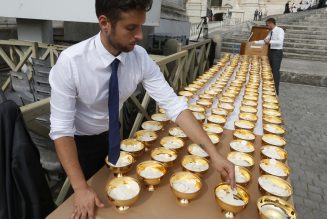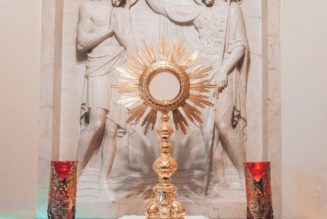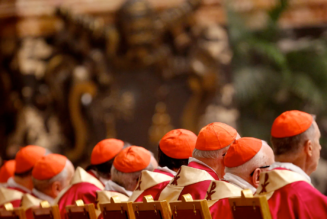By Phil Lawler ( bio – articles – email ) | Aug 24, 2020
A priest learns that he was not validly baptized. And since he was not validly baptized, his ordination was also invalid. And since he was not validly ordained, when he celebrated Mass or heard confessions, those sacraments weren’t valid, either. The Archdiocese of Detroit has a mess on its hands.
For Father Matthew Hood, who realized that he had been “baptized” with a formula that the Vatican recently declared invalid, the problem has already been corrected. He has been quickly baptized and ordained— validly, this time around— and going forward, his priestly ministry is on solid ground. But what about the past three years in ministry, when he and his parishioners innocently thought he was a Catholic priest, but he wasn’t?
Explaining the matter to the faithful, Detroit’s Archbishop Allen Vigneron underlined the crucial importance of following the proper approved rituals for the sacraments. Citing the recent Vatican statement, the archbishop said that the Second Vatican Council had “established that no one ‘even if he be a priest, may add, remove, or change anything in the liturgy on his own authority.”
I beg to differ. That’s not what Vatican II established; it’s what Vatican II said. What was actually established— that is, what happened as a matter of course in the years following the Council— was precisely the opposite.
The words of Vatican II (found in Sacrasanctum Concilum 22) are clear enough:
Regulation of the sacred liturgy depends solely on the authority of the Church, that is, on the Apostolic See and, as laws may determine, on the bishop…. Therefore no other person, even if he be a priest, may add, remove, or change anything in the liturgy on his own authority.
The Council of Trent had been equally clear on this point, as the recent Vatican statement noted. So Vatican II did not so much “establish” the authority of liturgical guidelines as reaffirm what was already in place. For centuries the Church has taught that her ministers, in conferring the sacraments, must closely follow the approved rituals.
But after Vatican II that discipline broke down. Not because of what the Council said— which we’ve just seen— but because of the attitudes that were tolerated, accepted, inculcated, and encouraged in the clergy. Whereas the pre-conciliar liturgy prescribed the priest’s every word and action during the Mass, the Novus Ordo Mass allowed the celebrant many new options. Priests responded by using those options— and then adding a few of their own, without waiting for approval.
Bishops might have told their priests to read the words of the approved translations and follow the rubrics— to “Say the black and do the red”— but in practice they allowed free-lancing. Priests began to add their own tropes to the language of the Missal, to “correct” translations they did not like, eventually to invent their own extemporaneous Eucharistic prayers. I vividly recall once informing a cardinal-archbishop that at Mass the previous Sunday, the priest had departed so far from the language of ordinary Eucharistic Prayer that I wasn’t sure the Mass had been valid. He calmly replied, “It’s always fine when I’m there.”
And that reaction, I suggest, was typical of how bishops have responded to reports of liturgical abuse. For decades now, variations from the liturgical norms have been the rule rather than the exception. A lay Catholic who complained about liturgical abuses could expect no sympathy from his pastor or his bishop. Why was he a stickler for the rules?
In 2004, the Vatican’s Congregation for Divine Worship acknowledged the problem (in Redemptionis Sacramentum): “In some places, the perpetration of liturgical abuses has become almost habitual, a fact which obviously cannot be allowed and must cease.” But even then bishops were not prepared to grapple with the issue. From Los Angeles, Cardinal Roger Mahony said:
Most of the abuses mentioned in Redemptionis Sacramentum) do not pertain to the celebration of the Eucharist in our archdiocese because of our many efforts to provide intensive and extensive training in proper liturgical norms and practice.
Because I have not visited Los Angeles since the turn of the century, I cannot contradict Cardinal Mahony from my own personal experience. But I am quite confident that readers will confirm that liturgical abuses were not unusual there. For that matter, I wonder whether there is any evidence of the “intensive and extensive training in proper liturgical norms and practice.”
When a minister of the Catholic Church willfully departs from the ritual that the Church has approved, that is always a liturgical abuse. It may be a minor abuse, in which case there will probably be no complaints or repercussions. Then again it might be a serious abuse, as in the case of Father Hood’s invalid baptism, wreaking havoc on the life of the Catholic community. But when minor abuses are routinely tolerated, more serious abuses become far more likely. Abuse is abuse, and as with sexual abuse, “zero tolerance” is the proper attitude.
Sound Off! CatholicCulture.org supporters weigh in.
All comments are moderated. To lighten our editing burden, only current donors are allowed to Sound Off. If you are a current donor, log in to see the comment form; otherwise please support our work, and Sound Off!











